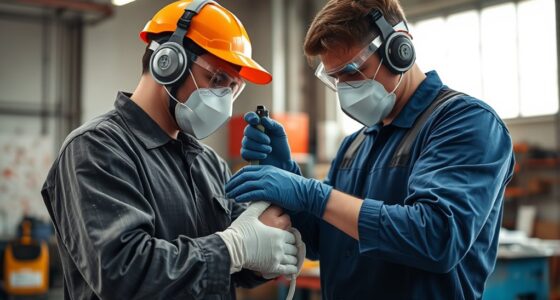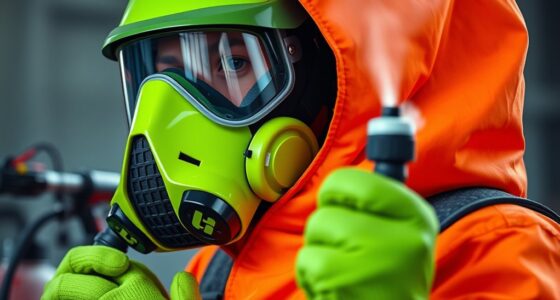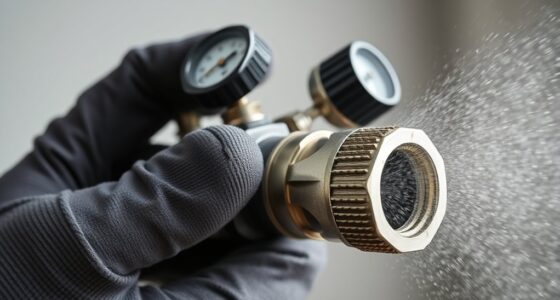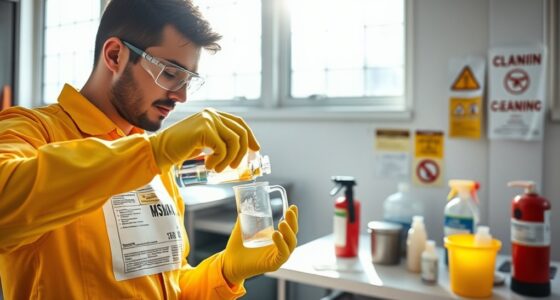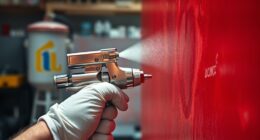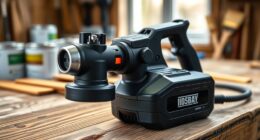Spray painting has the potential to transform the look of your walls, furniture, or even your vehicle, giving them a new and updated aesthetic. Although it may be exhilarating to enhance surfaces with vibrant colors and smooth finishes, it is important to be mindful of the potential hazards that come with this process.
From toxic fumes to accidental injuries, there are risks involved in spray painting that need to be addressed for both personal safety and compliance with regulations. In this blog post, we will dive into the world of spray painting hazards and explore effective control measures that every painter should know. So grab your goggles and prepare to discover how to protect yourself while unleashing your creativity!
Paint Spraying: What You Should Know
When it comes to paint spraying, there are a few key things you should know before diving in. First and foremost, it’s crucial to understand the risks associated with this method of painting. Spray painting involves the use of pressurized containers or machines to disperse paint particles into the air, which can pose hazards if proper precautions are not taken.

Assessing the Risks
One of the main risks when spray painting is exposure to toxic fumes and chemicals. Many paints contain volatile organic compounds (VOCs) that can be harmful if inhaled over prolonged periods. These VOCs can cause respiratory issues, eye irritation, dizziness, and even long-term health problems. Additionally, there is also a risk of skin contact with hazardous substances present in certain paints.
Controlling the Hazards
To minimize these risks, it’s important to control hazards through various means. One effective measure is ensuring proper ventilation in your workspace by using exhaust fans or opening windows and doors for fresh air circulation. This helps reduce the concentration of airborne contaminants.
Reviewing Safety Measures
In addition to ventilation, wearing personal protective equipment (PPE) is crucial when working with spray paint. This includes goggles or safety glasses to protect your eyes from splatters or overspray and a respirator mask specifically designed for filtering out harmful chemicals from inhalation.
Safety Basics and Beyond
Beyond PPE usage, practicing good housekeeping habits while spray painting is essential for preventing accidents. Keeping your work area clean and clutter-free reduces tripping hazards that could lead to falls or injuries during operation.
Compliance with OSHA Standards
It’s worth noting that adhering to Occupational Safety and Health Administration (OSHA) standards will help ensure a safe environment while spray painting. Familiarize yourself with OSHA guidelines specific to spray painting operations such as handling flammable materials safely and storing them appropriately.
Preventing Occupational Hazards
For those working in commercial or industrial settings where spray painting is a routine task, it is important to understand the risks associated with the job and take measures to protect yourself from these hazards. By following the safety tips outlined above, you can help ensure a safe working environment and prevent hazardous incidents from occurring while spray painting.
Assessing the Risks
When it comes to spray painting, it’s important to assess the risks involved. This step is crucial in ensuring the safety of both the painter and those around them. By identifying potential hazards upfront, you can take necessary measures to minimize or eliminate them.
The first risk to consider is exposure to harmful chemicals. Spray paints often contain volatile organic compounds (VOCs) that can be hazardous if inhaled or absorbed through the skin. These VOCs can cause respiratory issues, eye irritation, dizziness, and even long-term health problems. It’s essential to understand the specific chemicals present in your paint and take appropriate precautions.
Another risk associated with spray painting is fire hazards. Most spray paints are flammable or combustible liquids, which means they can easily ignite under certain conditions. Improper handling or storage of these materials can lead to fires and explosions. To prevent such incidents, ensure proper ventilation when spraying paint indoors and keep flammable materials away from ignition sources.
Additionally, there’s a risk of physical injury during spray painting activities. Accidental slips or falls while carrying heavy equipment like paint sprayers could result in bruises or fractures. Eye injuries are also common due to overspray particles entering unprotected eyes during application. Wearing personal protective equipment (PPE), such as gloves and goggles, is vital for minimizing these risks.
Moreover, improper disposal of leftover paint and cleaning solvents poses environmental hazards as well as potential health risks if not handled correctly. These substances should never be poured down drains or thrown into regular trash bins but disposed of according to local regulations.
Furthermore, working at heights presents its own set of dangers when using ladders or scaffolding for elevated surfaces that need painting attention – falling from heights may result in severe injuries or even fatalities.
Inadequate training on how to operate spraying equipment properly increases the likelihood of accidents occurring on job sites too; workers must receive comprehensive instruction on safe operating procedures before engaging in spray painting tasks.
It is crucial to assess the risks associated with prolonged exposure to spray painting activities in order to ensure safety for both the painter and those around them. By following the safety guidelines outlined above, you can help reduce the chances of hazardous incidents occurring while spray painting.
Controlling Hazards
When it comes to spray painting, understanding and controlling the hazards is crucial for the safety of both workers and the environment. The process of spray painting involves the release of potentially harmful particles into the air, which can pose serious health risks if not properly managed. In this section, we will explore some key methods for controlling these hazards.
1. Ventilation: One of the most effective ways to control hazards during spray painting is to ensure proper ventilation in the work area. This can be achieved through various means such as using exhaust fans or ensuring that windows and doors are open to allow fresh air circulation. By removing fumes and airborne particles from the workspace, ventilation helps minimize exposure and maintain a safer working environment.
2. Personal Protective Equipment (PPE): Workers involved in spray painting should always wear appropriate personal protective equipment to protect themselves from potential hazards. This may include respiratory masks or respirators designed specifically for chemical fumes, goggles or face shields to shield against splashes or sprays, gloves to prevent skin contact with chemicals, and coveralls or aprons for overall protection.
3. Hazardous Materials Management: Proper storage and handling of hazardous materials used in spray painting are essential for minimizing risks. Ensure that all paints, solvents, thinners, and other chemicals are stored securely in designated areas away from heat sources or ignition points. Additionally, provide clear instructions on how to handle these materials safely and dispose of them properly according to local regulations.
4. Training Programs: Comprehensive training programs should be implemented for all individuals involved in spray painting activities – including supervisors overseeing operations – emphasizing safe practices, hazard recognition,and emergency response procedures.
Special attention should be given towards educating workers about potential health effects associated with specific chemicals used within their work environment.
5. Engineering Controls: Implementing engineering controls can greatly help reduce hazards associated with spray painting.
Workers can benefit from specially designed paint booths equipped with controlled airflow systems,downdraft tables for smaller projects,and fume extractors to capture hazardous particles and gasses. Additionally, maintaining a clean work environment free of dust and debris can further reduce the risks associated with spray painting.
Reviewing Safety Measures
Spray painting can be a highly effective and efficient way to apply paint, but it also comes with its fair share of hazards. To ensure the safety of both workers and the environment, it is important to review and implement proper safety measures when engaging in spray painting activities.
One key aspect of reviewing safety measures involves assessing the risks associated with spray painting. This includes identifying potential health hazards such as exposure to toxic chemicals or harmful fumes. It is essential to understand how these hazards can affect individuals, both in terms of immediate effects and long-term consequences.
Controlling hazards is another crucial step in ensuring safe spray painting practices. This may involve implementing engineering controls such as ventilation systems or enclosures to minimize exposure to hazardous substances. Personal protective equipment (PPE) should also be provided and worn by workers to further reduce risk.
In addition to controlling existing hazards, it is important to regularly review safety measures for any necessary updates or improvements. This could include staying up-to-date on industry standards and regulations related to spray painting activities. By being proactive in maintaining a safe working environment, employers can effectively protect their employees from potential harm.
When reviewing safety measures for spray painting, it is important not only to focus on the immediate risks but also consider broader safety basics beyond just using PPE. Proper training for all workers involved in spray painting operations should be provided, covering topics such as equipment operation, hazard recognition, emergency procedures, and more.
Compliance with Occupational Safety and Health Administration (OSHA) standards is paramount when evaluating safety measures for spraying paints. OSHA provides guidelines specific to different industries that address various aspects of occupational health and safety including respiratory protection requirements, ventilation systems design criteria among others that should be followed closely.
Preventing occupational hazards starts with thorough planning before starting any project involving spray painting activities; this includes assessing appropriate work areas free from flammable materials nearby ignition sources among other precautions required while performing tasks safely.
By adhering to safety measures, individuals can significantly reduce the risk of accidents or health issues arising from spray painting activities.
Paint Spraying: What You Must Do
When it comes to spray painting, ensuring safety is of utmost importance. The right knowledge and precautions can make all the difference in preventing accidents and protecting your health. Here are some essential tips to keep in mind when it comes to paint spraying.
Always wear appropriate personal protective equipment (PPE). This includes a respirator mask, goggles or safety glasses, gloves, and coveralls. PPE acts as a barrier between you and potentially harmful chemicals or particles released during the painting process.
Proper ventilation is crucial. Make sure you are working in a well-ventilated area or use mechanical ventilation systems such as exhaust fans or air blowers. Adequate airflow helps minimize the risk of inhaling toxic fumes that can cause respiratory issues.
Follow manufacturer instructions for mixing paint properly. Incorrect ratios may result in unsafe chemical reactions or inconsistent coverage on surfaces being painted. Take the time to read labels carefully before beginning any project.
Moreover, never underestimate the importance of keeping your workspace clean and organized. Cluttered areas increase the likelihood of trips and falls while also making it difficult to locate necessary equipment when needed quickly.
Additionally, ensure that any electrical equipment used near flammable paints is explosion-proof or intrinsically safe. Sparks from faulty wiring can ignite volatile materials resulting in fires or explosions with serious consequences.
Furthermore, regular maintenance of your spray-painting tools is crucial for optimal safety performance. Check hoses regularly for leaks or damage which could lead to hazardous situations if left unaddressed; replace them promptly if needed.
Lastly but most importantly! Regular training on spray painting techniques should be provided not only for yourself but also for anyone working alongside you! Knowing how to handle sprayers correctly reduces risks significantly!
By following these basic safety measures while spray painting,! You will not only protect yourself but also create an environment where everyone involved feels secure.! Remember,! Safety should be at the forefront of every paint spraying project,! so be sure to take the necessary precautions each and every time.
Safety Basics and Beyond
When it comes to spray painting, safety should always be your top priority. In this section, we will discuss some safety basics and go beyond to ensure a secure working environment.
1. Personal Protective Equipment (PPE): Wearing the right PPE is essential when spray painting. Always use a respirator to protect yourself from inhaling harmful fumes or particles. Additionally, wear safety goggles or a face shield to safeguard your eyes from overspray and chemical splashes. Don’t forget to put on gloves and coveralls for added protection.
2. Ventilation: Adequate ventilation is crucial in minimizing exposure to hazardous chemicals found in spray paint mist or vapors. Ensure that you are working in a well-ventilated area, preferably with exhaust fans or open windows/doors that allow for proper airflow.
3. Fire Safety: Spray paints are highly flammable substances, so fire prevention measures are vital. Keep all potential ignition sources away from the work area, such as smoking materials or open flames. Have fire extinguishers readily available and know how to use them effectively.
4. Proper Handling of Chemicals: Before starting any spray painting project, familiarize yourself with the specific hazards associated with the paints and solvents being used. Follow manufacturer instructions regarding handling procedures, storage requirements, and disposal methods.
5. Cleaning up Safely: After completing your paint job, make sure you clean up properly by disposing of empty cans safely and storing leftover paint correctly (if applicable). Avoid pouring excess paint down drains or into regular trash bins; instead follow local regulations for disposal through recycling centers or designated facilities.
6. Workplace Organization: Maintaining an organized workspace can significantly reduce accidents while spraying paint. Ensure that walkways are clear of obstacles, properly store equipment when not in use, and regularly inspect tools for damage or defects before each new project
7. Education & Training: Stay updated on best practices by attending training sessions or workshops on spray painting safety. The more knowledge and skills you have, the less likely you are to make mistakes that could lead to injury or worse.
By following these essential safety steps, you can greatly reduce risks associated with spray painting activities. Taking the time to properly plan and prepare for each project is key to ensuring a safe working environment and preventing hazardous incidents from occurring.
Compliance with OSHA Standards
When it comes to spray painting, ensuring compliance with Occupational Safety and Health Administration (OSHA) standards is crucial. These regulations are designed to protect workers from potential hazards and ensure a safe working environment. By adhering to these guidelines, you can minimize the risks associated with spray painting activities.
One of the key aspects of OSHA compliance is providing proper training for employees engaged in spray painting tasks. This includes educating them about the potential hazards associated with paint spraying and how to properly use personal protective equipment (PPE). Training sessions should cover topics such as respiratory protection, ventilation requirements, handling hazardous materials, and emergency procedures.
In addition to training, it is important to implement engineering controls that reduce exposure levels. This may include using ventilation systems or exhaust hoods that effectively capture and remove overspray particles from the air. Regular maintenance and inspections of these systems are also essential for their effectiveness.
Another crucial aspect of complying with OSHA standards is conducting regular risk assessments. This involves identifying potential hazards in the workplace related to paint spraying activities and implementing appropriate control measures. It could involve evaluating factors such as chemical exposures, noise levels, ergonomic risks, or fire hazards. By addressing these identified risks promptly, you can prevent accidents or injuries before they occur.
Proper record-keeping is another requirement under OSHA standards. Employers must maintain documentation regarding employee training records on hazard communication programs; job safety analysis reports; medical surveillance records if required; inspection logs for equipment used during paint spraying; incident reports; and any other relevant documentation related to safety practices.
Furthermore, employers must ensure that all necessary personal protective equipment (PPE) is provided free of charge to employees who engage in paint spraying activities. This includes respirators fitted correctly according to individual needs along with eye protection such as goggles or face shields when needed.
Regular monitoring of workplace conditions by a competent person is also vital for maintaining compliance with OSHA standards. This person should be knowledgeable about paint spraying hazards, control measures, and safety procedures in order to identify any issues or deficiencies and take action to address them promptly.
Overall, by adhering to OSHA guidelines for paint spraying activities, employers can ensure a safe working environment for their employees and minimize risks associated with the job. By taking the necessary steps outlined above, you can help protect your workers from potential hazards while keeping your workplace compliant with regulations.
Preventing Occupational Hazards
When it comes to spray painting, preventing occupational hazards should be a top priority. The chemicals and fumes associated with this process can pose serious risks to the health and safety of workers. By implementing proper safety measures, you can significantly reduce these hazards and create a safer work environment.
First and foremost, it is crucial to provide adequate ventilation in the spray painting area. Proper ventilation helps remove harmful fumes from the air, reducing the risk of inhalation by workers. This can be achieved through the use of exhaust fans or other ventilation systems that effectively circulate fresh air into the workspace.
In addition to ventilation, personal protective equipment (PPE) plays a vital role in preventing occupational hazards during spray painting. Workers should wear appropriate respiratory protection such as respirators or masks specifically designed for chemical exposure. Eye protection in the form of goggles or face shields is also essential to prevent eye irritation or injury.
Regular maintenance of spraying equipment is another crucial step in hazard prevention. Equipment malfunctions can lead to accidents or release excessive amounts of paint particles into the air. Regular inspections and servicing will help identify any issues before they escalate into major problems.
Furthermore, providing proper training for employees is key in preventing occupational hazards related to spray painting. Training should cover topics such as handling hazardous materials safely, recognizing signs of overexposure, emergency procedures, and correct usage of PPEs.
Implementing good housekeeping practices can also contribute significantly towards hazard prevention. Keeping work areas clean and free from clutter reduces tripping hazards while minimizing potential sources of ignition like flammable materials near spraying operations.
Lastly but certainly not least important – regular monitoring should be conducted within your workplace environment where spray painting activities occur regularly – especially if you are using high-risk paints containing toxic substances such as lead-based paint or volatile organic compounds (VOCs). Periodic air sampling tests will ensure that levels remain within acceptable limits set by regulatory agencies.
By following these preventive measures, you can minimize the risks associated with spray painting and ensure a safe working environment for employees. Taking the time to review safety protocols and procedures can make all the difference in protecting your workers and preventing hazardous incidents from occurring.
Resources for Spray Painting Safety
Spray painting can be a hazardous task if proper safety measures are not followed. To ensure the well-being of workers and minimize potential risks, it is essential to have access to reliable resources for spray painting safety. These resources provide valuable guidance and tools that can help in understanding and controlling hazards associated with this process.
1. Helpful Guides and Tools: Numerous organizations offer comprehensive guides on spray painting safety. These guides cover topics such as personal protective equipment (PPE), ventilation requirements, safe handling of paint materials, and emergency response procedures. They provide step-by-step instructions on how to safely conduct spray painting operations while minimizing exposure to harmful chemicals.
2. Industrial Hygiene Reports and Product Testing: Many industrial hygiene agencies conduct research and testing related to paint products used in spray painting applications. Their reports often include information on the health effects of different paints, recommendations for safe usage, and guidelines for proper disposal methods. Accessing these reports can help individuals make informed decisions about selecting the right paint products that pose minimal risks.
3. Safety Data Sheets (SDS): SDS contain crucial information about the chemical composition of paints, including their potential hazards, first aid measures, recommended storage conditions, and handling precautions. It is important to consult SDS provided by manufacturers or suppliers before using any paint product for spray painting purposes.
4. Online Safety Resources: The internet provides a wealth of information on various aspects of spray painting safety. Dedicated websites from reputable sources like government agencies or industry associations offer articles, videos, infographics, checklists – all aimed at educating users about potential hazards involved in this process and providing practical tips for risk reduction.
5. Understanding Workplace Standards: Familiarizing yourself with Occupational Safety Health Administration (OSHA) standards is crucial when it comes to ensuring compliance with regulations related to spray painting activities.
Organizations should regularly review OSHA’s guidelines specific to their industry sector regarding hazard communication programs,respiratory protection,and engineering controls. OSHA also offers free consultation services to help businesses identify and address potential hazards related to spray painting operations.
Helpful Guides and Tools
When it comes to spray painting, having access to helpful guides and tools can make a world of difference. Whether you’re a beginner or an experienced painter, these resources can provide valuable information and support to ensure your safety and success.
1. Online Tutorials: The internet is a treasure trove of tutorials and step-by-step guides on spray painting techniques. From basic tips on how to hold the paint sprayer correctly to advanced techniques for achieving smooth finishes, you’ll find a wealth of knowledge at your fingertips.
2. Video Demonstrations: Sometimes seeing is believing, especially when it comes to learning new skills like spray painting. Video demonstrations allow you to observe experts in action, giving you visual cues on proper technique, equipment usage, and safety precautions. You can easily find video tutorials on popular platforms like YouTube.
3. Paint Spraying Manuals: Most paint sprayers come with user manuals that outline important instructions for safe operation and maintenance. These manuals often include troubleshooting tips, recommended settings for different types of paints, as well as cleaning guidelines.
4. Safety Data Sheets (SDS): When working with any type of paint or coating product, it’s crucial to familiarize yourself with its SDS. These documents provide detailed information about potential hazards associated with the product and offer guidance on safe handling practices, personal protective equipment (PPE) requirements, first aid measures in case of exposure or accidents.
5. Spray Booth Design Guides: If you plan on setting up a dedicated area for spray painting projects in your workshop or facility, consult spray booth design guides that provide recommendations for ventilation systems layout, lighting requirements,
and fire prevention measures specific to spraying operations.
6. Paint Calculator Apps: Estimating the amount of paint needed for a project accurately can be challenging but crucial when it comes to cost-efficiency and avoiding wastage.
To simplify this task,take advantage of mobile apps designed specifically for calculating paint quantities based on surface area dimensions provided.
7. Online Communities and Forums: Engaging with fellow spray painters through online communities or forums can be a valuable source of support. These platforms can provide answers to specific questions, help troubleshoot issues, and offer general advice on spray painting safety and techniques.
Industrial Hygiene Reports and Product Testing
When it comes to spray painting, safety should always be a top priority. Understanding the hazards associated with this process is crucial for protecting yourself and others in your workspace. One important aspect of ensuring safety is conducting industrial hygiene reports and product testing.
Industrial hygiene reports provide valuable insights into the potential health risks associated with spray painting. These reports analyze various factors such as ventilation systems, exposure levels, and personal protective equipment (PPE) requirements. By thoroughly assessing these areas, you can identify any potential hazards that may arise during the painting process.
Product testing plays an equally vital role in spray painting safety. This involves evaluating the composition of paint products to ensure they meet industry standards and regulations. Testing helps identify harmful substances such as volatile organic compounds (VOCs), which can have detrimental effects on human health when inhaled or absorbed through the skin.
The results from industrial hygiene reports and product testing enable you to make informed decisions about implementing control measures to minimize exposure to hazardous substances. For example, if high levels of VOCs are detected in a particular paint product, alternative options with lower VOC content can be considered.
Additionally, these reports help determine appropriate engineering controls like proper ventilation systems or exhaust fans that effectively remove airborne contaminants from your work area. Adequate ventilation not only protects workers but also ensures compliance with Occupational Safety and Health Administration (OSHA) standards.
Regularly monitoring air quality through sampling techniques is another essential part of maintaining a safe working environment during spray painting activities. This allows you to assess whether existing control measures are effective or if adjustments need to be made.
Furthermore, industrial hygiene reports serve as valuable documentation that demonstrates your commitment to maintaining workplace safety standards. They highlight proactive steps taken towards risk assessment and mitigation strategies – critical factors for business reputation and employee well-being alike.
By prioritizing industrial hygiene reports and product testing in your spray painting operations, you demonstrate a dedication towards creating a safe work environment while complying with relevant regulations. These reports provide essential insights for implementing control measures, selecting appropriate PPE, and assessing air quality to help protect yourself and others from potential hazards.
Connect with Experts
When it comes to ensuring safety in spray painting, it’s crucial to connect with experts who can provide valuable guidance and support. These professionals have extensive knowledge and experience in the field, making them a valuable resource for understanding hazards and control measures.
1. Safety Professionals: Safety professionals specialize in identifying and mitigating workplace hazards. They can conduct risk assessments specific to your spray painting operations and offer tailored solutions to minimize risks. By consulting with these experts, you can gain insights into best practices, regulations, and industry standards that will help you create a safe working environment.
2. Industry Organizations: Joining industry organizations related to paint spraying can be an excellent way to connect with other professionals facing similar challenges. These organizations often host conferences, seminars, or webinars where you can learn from experts through presentations or panel discussions. Additionally, they may offer resources such as guidelines or case studies that address common spray painting hazards.
3. Networking Events: Participating in networking events allows you to meet professionals from different industries who may have encountered similar issues during their work processes. Building connections with these individuals not only expands your network but also provides opportunities for knowledge sharing on effective hazard control measures.
4. Online Forums: Online forums dedicated to occupational safety are another avenue for connecting with experts in the field of spray painting safety. These platforms allow users to ask questions directly and receive responses from experienced individuals or industry specialists who frequent these spaces.
5. Tutorials & Webinars: Many companies specializing in industrial hygiene provide online tutorials or webinars covering various topics related to managing hazards associated with spray painting operations.
These instructional materials are usually created by subject matter experts who possess a deep understanding of the subject matter.
They often include demonstrations of proper techniques,maintenance tips,and critical precautions when handling paints,solvents,and equipment.
This type of information is invaluable for those looking for expert advice without necessarily having direct access to consultants locally.
6. Consultancy Services: If you require in-depth guidance tailored to your specific spray painting setup, engaging the services of a professional consultant may be the ideal option. They can assess your workplace and provide recommendations on how to improve safety compliance while keeping operations efficient and cost-effective.
Getting in Touch with Safety Professionals
When it comes to spray painting, safety should always be the top priority. Whether you’re a DIY enthusiast or a professional painter, it’s crucial to understand and mitigate the hazards associated with this activity. While there are various resources available to help you learn about these risks and control measures, sometimes it’s best to seek expert guidance. That’s where safety professionals come in.
1. Safety professionals are individuals who have extensive knowledge and experience in occupational health and safety practices. They specialize in identifying potential hazards, assessing risk levels, and implementing effective control measures. If you want to ensure that your spray painting activities are conducted safely, getting in touch with these experts is highly recommended.
2. One way of connecting with safety professionals is through consulting firms that offer occupational health and safety services. These firms typically employ certified professionals who can provide guidance tailored to your specific needs. They can assess your work environment, identify potential hazards related to spray painting operations, and develop comprehensive plans for hazard control.
3. Another option is reaching out to government agencies responsible for workplace safety regulations such as OSHA (Occupational Safety and Health Administration). OSHA provides a wealth of information on various topics including spray painting hazards and control measures through their website or local offices.
4. In addition to consulting firms and government agencies, industry organizations also play a significant role in promoting safe practices within specific sectors like construction or automotive refinishing. These organizations often have dedicated committees or resources focused on spray painting safety which include access to experts who can answer questions or provide advice.
5. Social media platforms can also serve as an avenue for connecting with safety professionals related specifically to the field of spray painting hazards and control measures There are numerous groups or communities online where individuals share their experiences, ask questions,and receive guidance from experts in real-time conversations
6 By getting in touch with these industry professionals,you’ll gain valuable insights into best practices when using sprayers,paint booths,and other equipment. They can help you understand the importance of proper ventilation, personal protective equipment, and containment strategies. Additionally, they can assist you in developing a comprehensive safety plan that meets the requirements of applicable regulations.
Connecting with Industry Organizations
To ensure that you stay up to date on the latest safety measures and best practices in spray painting, it’s essential to connect with industry organizations. These organizations are dedicated to promoting safe working environments and providing resources for businesses involved in spray painting.
By becoming a member of these organizations, you can gain access to valuable information, training materials, and networking opportunities. You’ll have the chance to interact with experts in the field who can offer guidance on how to effectively control hazards related to spray painting.
Additionally, industry organizations often host conferences, seminars, and webinars where you can learn from renowned professionals and stay informed about advancements in paint spraying safety. These events provide an excellent platform for sharing experiences and knowledge with peers who face similar challenges.
Some well-known industry organizations include the Occupational Safety and Health Administration (OSHA), National Fire Protection Association (NFPA), American Industrial Hygiene Association (AIHA), Society for Protective Coatings (SSPC), among others. By connecting with these reputable institutions, you can take advantage of their expertise and keep your spray painting operations as safe as possible.
Remember: Safety should always be a top priority when it comes to any workplace activity involving hazardous materials like paints or coatings. Stay informed about potential risks associated with spray painting through reliable sources such as government agencies or professional associations. Implement effective control measures outlined by regulatory bodies like OSHA while seeking advice from experienced safety professionals whenever necessary.
So why wait? Take action today! Assess the risks associated with your paint spraying activities, implement appropriate controls measures, review safety protocols regularly; all while staying connected with industry organizations devoted to keeping workers safe during this process.
By following these steps diligently, you will create a safer work environment for yourself and your employees while minimizing potential hazards related to spray painting operations. Stay vigilant – because when it comes down to it – nothing is more important than ensuring everyone’s health and well-being at work!
Remember: spray painting hazards and control measures should never be taken lightly, so make sure to stay connected with industry organizations for the latest information and resources available.



